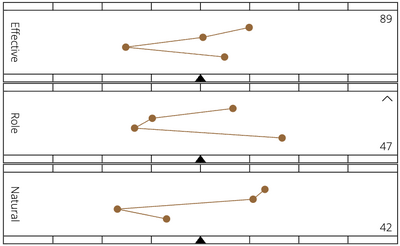Performance at Heart
Individual performance is represented by GRI with adaptive profiles like the one on the right. This article explains some of their key aspects.
What the Profiles Tell
The profile informs about a person’s most natural way to perform (Natural, the graph at the bottom), the perception to adapt to the environment (Role, the graph in the middle) and how both graphs translate into the effective way to perform (Effective, the graph on the top), the one that most probably will be observed.
Each graph shows four factors (the four small dots) and scales (above and below the graphs) that indicate the strength and direction of behavior. From a functional point of view, an adaptive profile assesses a person’s mode of action, its direction, and intensity. It’s not about their personality traits or types, although those concepts can be inferred from the adaptive profiles.
Relearning Performance
Like any instrument, trusting the results requires some initial effort, which one might be willing to put in if they see benefits. Having some understanding of how people function, behave, and adapt can then open new perspectives at an organizational level. This can help improve individual efficiency and performance, while also boosting a group's overall performance, reducing its chance of underperformance, and consequently benefiting each member.
Looking Beyond Usual Characteristics
The information from the adaptive profiles focuses on performance, offering a perspective on people that goes beyond their interests, skills, and intellect. It considers how they function fully with their brains, hearts, and guts within the context of their unique experiences and environment. By helping people get into their flow state, adapt to the environment in an engaging way, and clearly identify how they will underperform, the adaptive profiles redefine how individuals and their organizations can enhance performance. The practicality of this information makes it applicable in many settings close to where decisions and actions regarding people are made.
The Same Happened with Other Measures
What happens with those measures is no different from other measures of, let’s say, time, temperature, distance, and weight, once their measurement is available with an instrument and can be trusted. Their results can be used in a way that enhances the objectivity of the concepts being measured and allows for their use in ways that were not possible before. Of critical importance is the quality and practicality of the measure, which are discussed in other articles. Operationalizing the performance construct with the adaptive profiles allows for viewing the various models of performance from a new perspective and to make the most of them to benefit organizations and their stakeholders.

